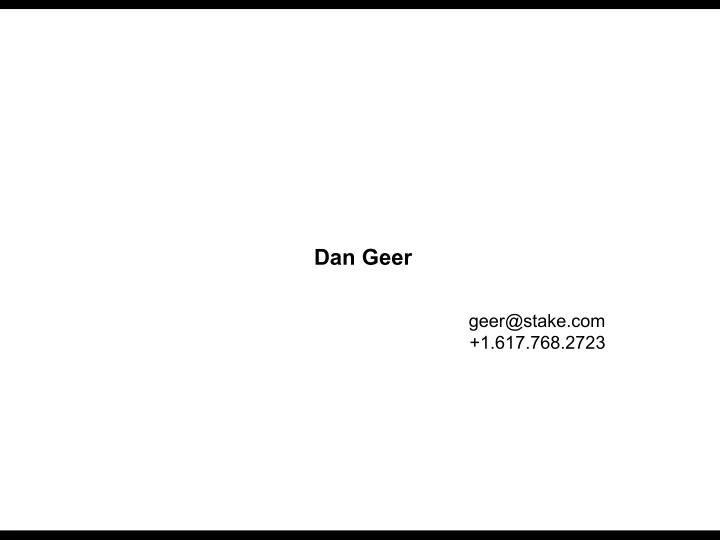

Dan Geer geer@stake.com +1.617.768.2723
Art v. Science
Characterization and Specialization
Time Line and Drivers
Put up or shut up...
Applications are where the action is ! Security trends say so ! Business realities say so ! Risk management needs quantitative decision support ! Application pen-tests can yield that support
Security trend 1 Applications are federating ! Distributed applications have multiple security domains – The firm : client service & administrative functions – External providers : front-end Web farms and application hosting – Partner interfaces : data streams (inventory, payment, real-time feeds) ! Applications get ever more moving parts – Mainframe → client-server → n -tier → Model 2 (J2EE and .Net) ! Network service stratification – Bandwidth, hosting, provisioning, delivery
Security trend 2 Perimeter defense is increasingly diseconomic ! “Shared wire” supplants “shared model” – XML is the great equalizer – SOAP and XML-RPC specifically designed to go through firewalls – Emerging web services ! Firewalls stop nuisance attacks, not application traffic – Everyone leaves ports 80 and 443 open ! As a result, the threat model mutates – More attacks through HTTP, at application level – More attacks targeted at specific application components – Attacks on applications require lower skill levels
Security trend 3 Data, data everywhere ! Data storage needs increasing Moore’s Law, 18mo doubling Storage, 12mo doubling exponentially Bandwidth , 9mo doubling – More new data produced in next 3 years than in all of price 1.00 human history – Corporate IT spending 4% in 1999 v. 17% in 2003 0.75 (Forrester) ! Form factors proliferating 0.50 – Local storage – Storage arrays 0.25 – Appliances/network-attached storage 0.00 0 1 2 3 4 5 6 7 8 9 10 years
Corresponding business realities ! Risk management has won ! Anticipate failure or be damned ! Demand for security expertise exceeding supply But most importantly, ! The future belongs to the quants
Quantitative decision support for risk management ! Annualized Loss Expectancy = ∑ (probability * business impact) Before investment, and after ! Net Present Value Increased Revenues ! Improved Uptime ! Transactional Frequency ! New Referrals Future cash Decreased Direct Costs flows Developer Re-work ! discounted by ! System Administrator Labor cost of funds ! Patch Release Costs ! Customer Retention Cost Avoidance (soft costs) Media/Legal ! = Net Investment Return
Treat application security as you would quality Relative cost to fix issues , Software development costs , by stage by stage Design 1 Design 15% Implementation 6.5 Implementation 60% Testing 15 Testing 25% Maintenance 100 Source: Implementing Software Inspections , Source: Architectures for Software Systems , IBM Systems Sciences Institute, IBM, 1981 course Notes, Garlan & Kazman, CS, CMU, 1998
A little example of pooled data Security evaluation of major applications treated as a source of summary numbers and shared intelligence All data are real, pooled and hence anonymized within a trust relationship, and modeled as normative
Application Penetration Testing Approach Generate Document Build Test Define Target Understand Findings Findings Environment Application(s) Architecture (as req.) Iterate Analyze Up-to-date Component Hypothesize Vulnerability/ Threat Threats Discuss Develop Knowledge Vulnerability Action Plan for Risk Improvement Identify Risks Develop Understand Analysis Technical and Approach Business Context Analyze Implement Risks Plan Conduct Proof of Concept (as req.)
Finding 1/4: Security defects are common Security Defects by Category Top 10 Application Security Defects Engagements Serious Session replay/hijacking 31% where Design design Category observed related flaws* Password controls 27% Administrative interfaces 31% 57% 36% Buffer overflows 27% Authentication/access control 62% 89% 64% File/application enumeration 27% Configuration management 42% 41% 16% Weak encryption 24% Cryptographic algorithms 33% 93% 61% Password sniffing 24% Information gathering 47% 51% 20% Cookie manipulation 20% Input validation 71% 50% 32% Parameter manipulation 33% 81% 73% 20% Administrative channels Sensitive data handling 33% 70% 41% 20% Log storage/retrieval issues Session management 40% 94% 79% 20% Error codes Total 45 70% 47% Assessments where *Scores of 3 or higher for exploit risk and business impact encountered , percent Source: 2002 @stake - The Hoover Project (n=45)
Finding 2/4: Leaders have fewer defects Average defects per engagement , by risk category 23.0 6.5 3.3 2.7 1.2 0.7 0.3 Administrative Authentication and Configuration interfaces access control management 3.5 1.0 1.3 1.3 Fourth 0.3 0.5 quartile Cryptographic Information Input validation 4.8 algorithms gathering 3.3 3.3 First 1.8 quartile 0.7 0.3 0.2 Parameter Sensitive data Session Overall manipulation handling management Source: 2002 @stake - The Hoover Project (n=23)
Finding 3/4: Leaders carry less risk Bottom quartile Top quartile Risk reduction 82% Business-adjusted risk index 60 score 331.8 score Administrative interfaces 36.2 4.0 89% Authentication/access control 85.2 10.3 88% Configuration management 36.3 76% 8.7 Cryptographic algorithms 6.8 2.5 63% Information gathering 11.0 8.8 20% Input validation 46.3 14.5 69% Parameter manipulation 31.5 3.3 89% Sensitive data handling 34.5 2.5 93% Session management 44.0 5.3 88% Average business-adjusted risk (BAR) index per engagement , with breakdown by risk category Source: 2002 @stake - The Hoover Project (n=23). BAR index = sum of all defects’ individual BAR scores, where each defect’s score = exploit risk (5 point scale) x business impact (5 point scale).
Finding 4/4: Fixing security defects earlier pays off ! Although benefits can be found throughout the lifecycle, earlier involvement is most beneficial ! Vulnerabilities are harder to address post-design ! System-wide changes Security ROI by Phase may be required at 25% later stages 21% 20% ! Enabling 15% improvements 15% 12% can be made Return on Security Investment (NPV) at design state 10% 5% 0% Design Implementation Testing Source: 2002 @stake - The Hoover Project
Repeating: Applications are where the action is ! Security trends say so ! Business realities say so ! Risk management means quantitative decision support ! Application pen-tests can yield that support And if they don’t, what’s the point?
Questions?
Recommend
More recommend